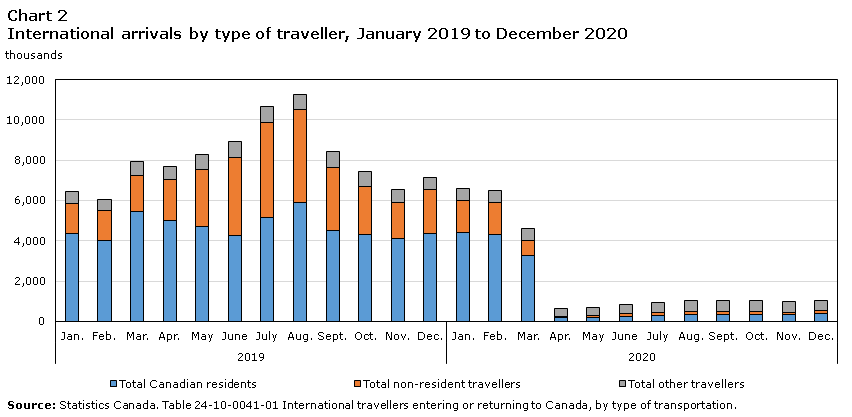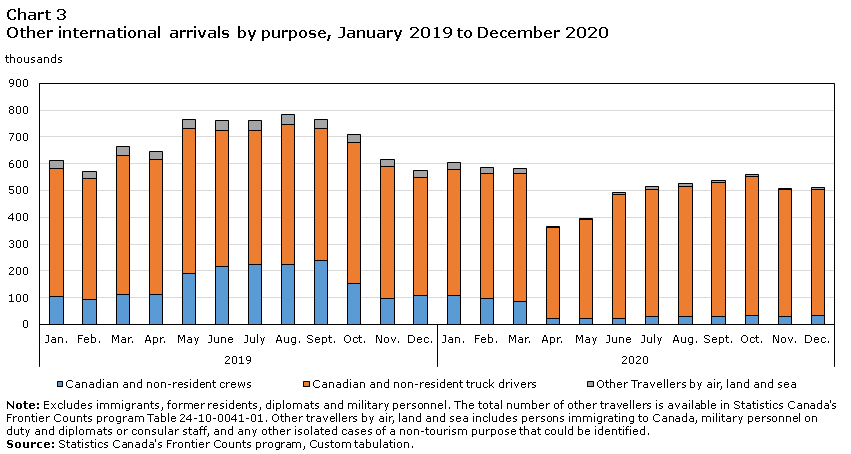 StatCan COVID-19: Data to Insights for a Better Canada Crossing the border during the pandemic: 2020 in review
StatCan COVID-19: Data to Insights for a Better Canada Crossing the border during the pandemic: 2020 in review
Archived Content
Information identified as archived is provided for reference, research or recordkeeping purposes. It is not subject to the Government of Canada Web Standards and has not been altered or updated since it was archived. Please "contact us" to request a format other than those available.
by Tanja Armenski, Brendan Sheahan, Duncan Currie and Larry McKeown
Text begins
Pandemic curtails border traffic
Since March 2020, there have been a travel advisory on non-essential travel and a partial border closing as well as a mandatory 14-day quarantine period for international travellers arriving in Canada due to the pandemic, all having an impact in reducing travel in and out of the country.
While these travel restrictions on discretionary travel to and from Canada were in effect since mid-March, an exemption was granted to essential travel such as the movement of goods and certain workers. Since April 30, 2020, this exemption applied to truck drivers and crew members of air, train and marine transport engaged in the delivery of essential supplies and equipment across the border.
As a result of these restrictions and exemptions, the number of non-residents (i.e. residents of United States and other countries) and returning Canadians (i.e. from the United States and other countries) declined in 2020 while other types of travel across the border continued.
This study examines international arrivals to Canada from January 2019 to December 2020 broken down by type of traveller.
International arrivals fall sharply
To help contain the spread of the virus, the federal government closed its international border to foreign nationals (excluding Americans) on March 16. A restriction on non-essential travel across the Canada-United States border was then implemented on March 21.
After the March restrictions took effect, the impact on international travel was immediate, with the number of international travellers (i.e. non-residents, returning Canadians and other travellers such as truck drivers and crew members) falling to a low of 614,000 in April, down 92.0% from the same month a year earlier (Chart 1).
After reaching this low, the number of persons arriving in Canada grew steadily. By June, the number increased to over 850,000, then surpassed one million by August and remained near that level for the remainder of the year, ending with 1.05 million arrivals in December, the most since March. Despite the increase, the number of international arrivals remained well below pre-pandemic levels, plummeting from an annual total of 96.8 million in 2019 to 25.9 million in 2020.

Data table for Chart 1
| 2019 | 2020 | |
|---|---|---|
| thousands | ||
| January | 6,460 | 6,603 |
| February | 6,067 | 6,472 |
| March | 7,917 | 4,599 |
| April | 7,701 | 614 |
| May | 8,289 | 679 |
| June | 8,919 | 859 |
| July | 10,652 | 944 |
| August | 11,282 | 1,030 |
| September | 8,424 | 1,010 |
| October | 7,427 | 1,039 |
| November | 6,531 | 962 |
| December | 7,142 | 1,046 |
| Source: Statistics Canada. Table 24-10-0041-01 International travellers entering or returning to Canada, by type of transportation. | ||
Of course, the impact of closures and restrictions was greater on some types of travel than on others (Figure 2). The numbers of non-residents and returning Canadian travellers, which comprised just over three-quarters (76%) of all international arrivals to Canada in 2020, declined by 77.8% year over year to 19.7 million in 2020 due to COVID-19. The number of non-resident travellers to Canada dropped 84.4% year over year to 5.1 million, while returning Canadian travellers declined 74.0% to 14.6 million.
With the travel restrictions and quarantine measures, non-resident travel to Canada almost disappeared after March with a devastating impact on tourism. According to the National tourism indicators, spending by international visitors during the third quarter was just a small fraction of what was spent during the same period in 2019.
Meanwhile, with some travel deemed essential, the number of “other travellers”, including non-resident and Canadian crews as well as truck drivers, also declined to 6.2 million in 2020, down 24.8% from 2019.

Data table for Chart 2
| Total Canadian residents | Total non-resident travellers | Total other travellers | |
|---|---|---|---|
| thousands | |||
| 2019 | |||
| January | 4,356 | 1,492 | 611 |
| February | 4,002 | 1,494 | 571 |
| March | 5,450 | 1,804 | 663 |
| April | 4,983 | 2,071 | 646 |
| May | 4,715 | 2,809 | 765 |
| June | 4,272 | 3,887 | 760 |
| July | 5,179 | 4,713 | 760 |
| August | 5,886 | 4,612 | 783 |
| September | 4,513 | 3,144 | 766 |
| October | 4,295 | 2,423 | 710 |
| November | 4,130 | 1,787 | 614 |
| December | 4,377 | 2,192 | 573 |
| 2020 | |||
| January | 4,431 | 1,567 | 605 |
| February | 4,290 | 1,596 | 587 |
| March | 3,258 | 760 | 581 |
| April | 181 | 68 | 365 |
| May | 196 | 86 | 397 |
| June | 247 | 122 | 491 |
| July | 287 | 142 | 516 |
| August | 345 | 159 | 526 |
| September | 325 | 148 | 538 |
| October | 341 | 140 | 558 |
| November | 326 | 127 | 509 |
| December | 379 | 154 | 513 |
| Source: Statistics Canada. Table 24-10-0041-01 International travellers entering or returning to Canada, by type of transportation. | |||
Keep on trucking!
While the numbers of non-residents and returning Canadian travellers declined sharply last April and are still far below levels of previous years, other arrivals to Canada recovered more quickly after an initial drop. These “other arrivals” primarily include Canadian and American truck drivers as well as crew members travelling internationally on different modes of transport. This other group, mostly essential travellers, have a proportionately larger share of the total after March (Chart 2).
During 2019 and the first quarter of 2020, other arrivals accounted for fewer than one of every 10 travellers entering Canada. Of these other arrivals, truckers were about three quarters (74.5%) while crew members - air, ship, and train - represented 21.0%. Since last April however, other arrivals have accounted for over one half (54%) of all travel into Canada, with truckers now accounting for over 91% of such arrivals (Chart 3).
Truck drivers have played a key role in supply chains during this time of historic disruption by keeping grocery store shelves stocked during the lock-downs—despite the daily challenges of finding safe places to stop for meals and rest. Canadians also increased their online spending during the pandemic, with e-commerce sales up by three-quarters (+75.9%) year-over-year in November alone. Most of those goods arrived by truck.

Data table for Chart 3
| Total Canadian residents | Total non-resident travellers | Total other travellers | |
|---|---|---|---|
| thousands | |||
| 2019 | |||
| January | 105 | 477 | 29 |
| February | 94 | 452 | 25 |
| March | 112 | 520 | 31 |
| April | 111 | 502 | 33 |
| May | 189 | 542 | 34 |
| June | 215 | 509 | 35 |
| July | 225 | 500 | 35 |
| August | 223 | 525 | 36 |
| September | 239 | 492 | 35 |
| October | 154 | 524 | 32 |
| November | 98 | 490 | 27 |
| December | 107 | 441 | 26 |
| 2020 | |||
| January | 108 | 470 | 26 |
| February | 98 | 463 | 25 |
| March | 84 | 479 | 18 |
| April | 21 | 341 | 3 |
| May | 21 | 372 | 4 |
| June | 23 | 461 | 6 |
| July | 28 | 476 | 11 |
| August | 31 | 485 | 10 |
| September | 30 | 499 | 9 |
| October | 33 | 518 | 7 |
| November | 30 | 472 | 7 |
| December | 34 | 470 | 9 |
|
Note: Excludes immigrants, former residents, diplomats and military personnel. The total number of other travellers is available in Statistics Canada's Frontier Counts program Table 24-10-0041-01. Other travellers by air, land and sea includes persons immigrating to Canada, military personnel on duty and diplomats or consular staff, and any other isolated cases of a non-tourism purpose that could be identified. Source: Statistics Canada's Frontier Counts program, Custom tabulation. |
|||
Method
Statistics Canada's Frontier Counts program uses administrative data from the Canada Border Services Agency to enumerate all international travellers who have been cleared for entry or re-entry into Canada, including residents of Canada, the United States and overseas countries. There is a full range of statistics on the number of international travellers by status and type of transport including the number of automobiles, trucks and other vehicles entering Canada. The data presented in this analysis are not seasonally adjusted.
Status of international traveller refers to the country of residence of all person arriving in Canada who cleared through customs points of entry:
- Total non-resident travellers
- United States residents entering Canada
- Residents of countries other than United States entering Canada
- Total Canadian resident travellers
- Canadian residents returning from the United States
- Canadian residents returning from other countries
- Total other travellers
- Immigrants and former residents
- Non-resident crews (including truckers)
- Canadian crews (including truckers)
A Canadian resident traveller is a Canadian resident who has travelled outside Canada for a period of less than 12 months.
A non-resident traveller is a resident of a country other than Canada who is travelling to Canada for a period of less than 12 months.
Other travellers consist of foreign and resident crew members (airplane, ship and train), truck drivers, immigration, military, and diplomats.
The Frontier Counts program does not distinguish travellers by trip purpose to non-essential (discretionary) and essential, however most of “other travellers” including foreign and resident crew members (airplane, ship and train) and truck driver have been exempt from the Emergency Orders made under the Quarantine Act as travellers essential to the movement of goods and people.
- Date modified:
